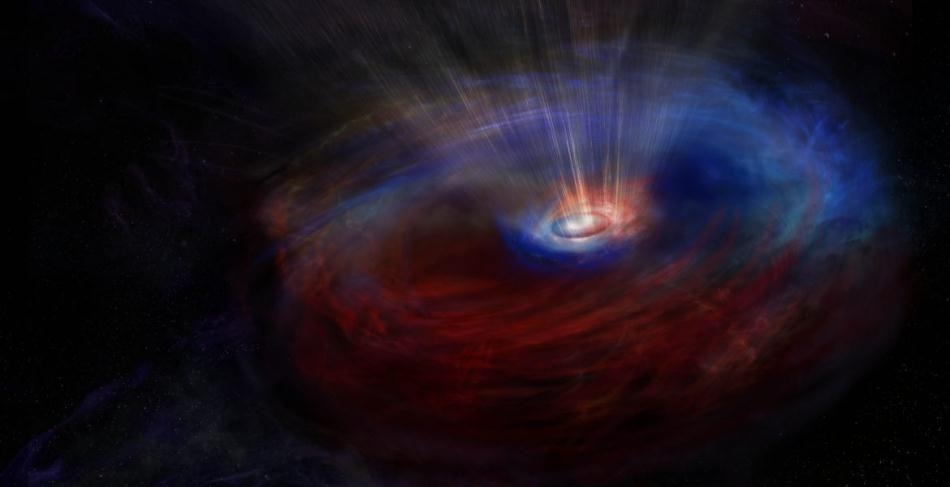Oct 16 2019
A supermassive black hole hides at the center of a galaxy called NGC 1068 within a thick doughnut-shaped cloud of gas and dust. Using the Atacama Large Millimeter/submillimeter Array (ALMA), astronomers have studied this cloud more closely and discovered that they could describe why supermassive black holes grew very quickly in the early Universe.

Image credit: S. Dagnello, NRAO/AUI/NSF
“Thanks to the spectacular resolution of ALMA, we measured the movement of gas in the inner orbits around the black hole,” explains Violette Impellizzeri of the National Radio Astronomy Observatory (NRAO), working at ALMA in Chile and lead author on a paper published in the Astrophysical Journal. “Surprisingly, we found two disks of gas rotating in opposite directions.”
Supermassive black holes were already present when the Universe was young—about a billion years after the Big Bang. But how these great objects, whose masses measure nearly billions of times the mass of the Sun, had time to grow in such a fairly short span of time, is an unresolved question among astronomers. This new discovery using ALMA could offer a clue.
Counter-rotating gas streams are unstable, which means that clouds fall into the black hole faster than they do in a disk with a single rotation direction. This could be a way in which a black hole can grow rapidly.
Violette Impellizzeri, Study Lead Author, NRAO
NGC 1068 (also referred to as Messier 77) is a spiral galaxy about 47 million light-years from Earth in the path of the constellation Cetus. At its middle region is an active galactic nucleus, a supermassive black hole that is vigorously feeding itself from a thin, rotating disk of gas and dust, also called an accretion disk.
Earlier ALMA observations exposed that the black hole is not only gulping down material, but also expelling gas at extremely high speeds—up to 500 km per second (over one million miles per hour). This gas that happens to be expelled from the accretion disk probably contributes to the concealing of the region around the black hole from optical telescopes.
Impellizzeri and her team used ALMA’s outstanding zoom lens ability to study the molecular gas around the black hole. Surprisingly, they discovered two counter-rotating disks of gas. The inner disk spans 2-4 light-years and trails the rotation of the galaxy, while the outer disk (also called the torus) spans 4-22 light years and is spinning the opposite way.
We did not expect to see this, because gas falling into a black hole would normally spin around it in only one direction. Something must have disturbed the flow, because it is impossible for a part of the disk to start rotating backward all on its own.
Violette Impellizzeri, Study Lead Author, NRAO
Counter-rotation is not an uncommon occurrence in space. “We see it in galaxies, usually thousands of light-years away from their galactic centers,” explained co-author Jack Gallimore from Bucknell University in Lewisburg, Pennsylvania. “The counter-rotation always results from the collision or interaction between two galaxies. What makes this result remarkable is that we see it on a much smaller scale, tens of light-years instead of thousands from the central black hole.”
The astronomers believe that the backward flow in NGC 1068 could be the result of gas clouds that dropped out of the host galaxy, or by a small passing galaxy on a counter-rotating orbit trapped in the disk.
At present, the outer disk seems to be in a steady orbit around the inner disk.
That will change when the outer disk begins to fall onto the inner disk, which may happen after a few orbits or a few hundred thousand years. The rotating streams of gas will collide and become unstable, and the disks will likely collapse in a luminous event as the molecular gas falls into the black hole. Unfortunately, we will not be there to witness the fireworks.
Jack Gallimore, Study Co-Author, Bucknell University
The National Radio Astronomy Observatory is a facility of the National Science Foundation, managed under cooperative agreement by Associated Universities, Inc.